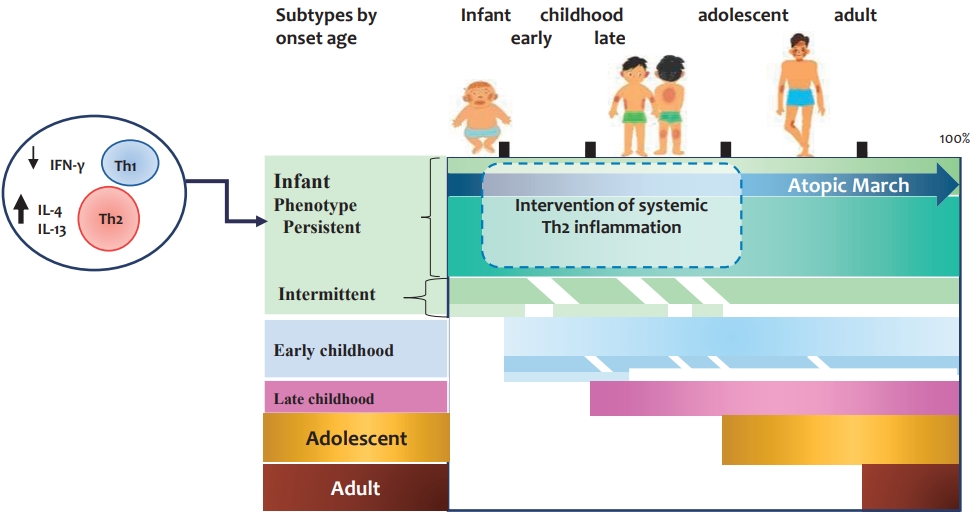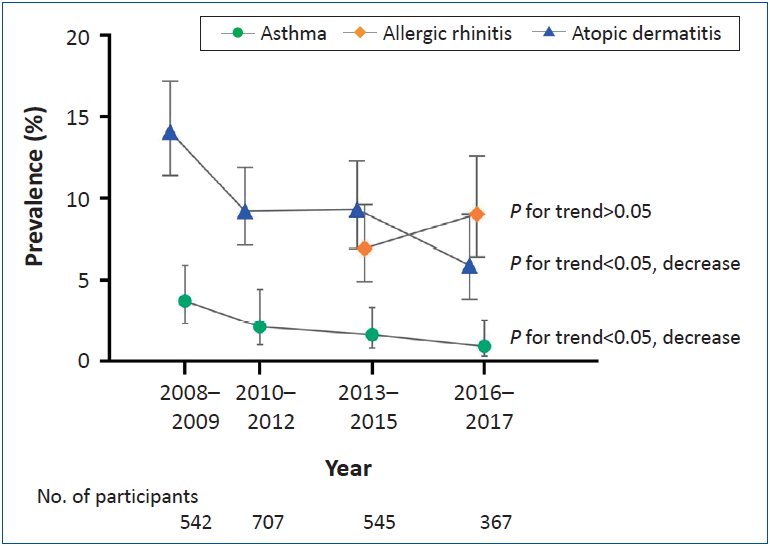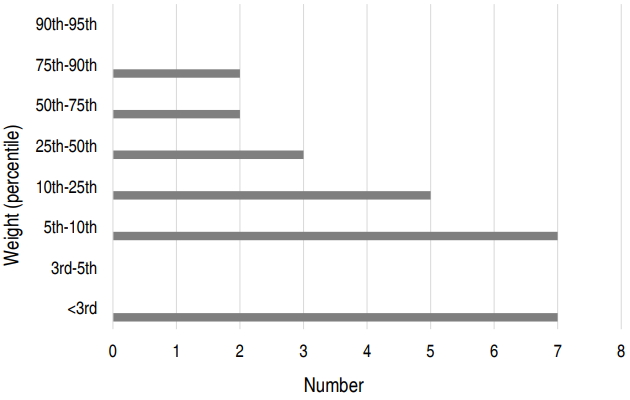Search
- Page Path
-
- HOME
- Search
- Review Article
- Critical Care Medicine
- Recent updates on systemic treatment of atopic dermatitis
- Jiyoung Ahn
- Clin Exp Pediatr. 2024;67(11):580-588. Published online November 1, 2024
-
Atopic dermatitis (AD) is a complex disease with multifactorial pathogenesis and variable clinical presentation. Up to one-fifth of patients with AD develop moderate to severe disease that is often refractory to classical therapies and can compromise quality of life. This review summarizes recent clinical evidence on biological agents and small-molecule immunotherapies for the treatment of AD.
- Allergy
- Skin and oral intervention for food allergy prevention based on dual allergen exposure hypothesis
- Kiwako Yamamoto-Hanada, Yukihiro Ohya
- Clin Exp Pediatr. 2024;67(10):477-485. Published online June 14, 2023
-

To prevent food allergy in infants, based on the dual allergen exposure hypothesis, we recommend a personalized approach consisting of both skin intervention (eczema treatment to achieve early remission and well-controlled skin without eczema to prevent percutaneous immunoglobulin E sensitization) and oral intervention (early allergenic food introduction).
- Moderate to severe atopic dermatitis in children: focus on systemic Th2 cytokine receptor antagonists and Janus kinase inhibitors
- Jeong Hee Kim, Mona Salem Samra
- Clin Exp Pediatr. 2024;67(2):64-79. Published online June 14, 2023
-

· Atopic dermatitis (AD) is characterized by a strong T helper (Th)2 response, although the extents of Th22, Th17/ interleukin (IL)-23, and Th1 responses vary among disease subtypes.
· Children with moderate to severe AD may require early systemic therapy to reduce the systemic inflammation caused by increased Th2 cytokine levels.
· Dupilumab, which blocks IL-4/IL-13 receptor, has equivalent efficacy for extrinsic and intrinsic AD and a favorable safety profile in infants and children aged 6 months and older.
- Original Article
- Allergy
- Influence of age at complementary food introduction on the development of asthma and atopic dermatitis in Korean children aged 1–3 years
- Jihyun Lee, Meeyong Shin, Bora Lee
- Clin Exp Pediatr. 2021;64(8):408-414. Published online November 1, 2020
-

Question: Is age at the time of complementary food introduction associated with asthma and atopic dermatitis (AD) in early childhood?
Finding: We found no significant association between age at the time of complementary food introduction and the incidence of AD and asthma in Koreans aged 1–3 years.
Meaning: Our findings suggest that the influence of individual allergenic foods on the development of AD and asthma should be clarified.
- Ten-year trends and prevalence of asthma, allergic rhinitis, and atopic dermatitis among the Korean population, 2008–2017
- Jihyun Ha, Seung Won Lee, Dong Keon Yon
- Clin Exp Pediatr. 2020;63(7):278-283. Published online January 29, 2020
-

Background: Major questions remain regarding the agestratified trends of allergic diseases and asthma in Korea.
Purpose: To identify the estimated recent prevalence and 10- year trends in asthma, allergic rhinitis, and atopic dermatitis among the Korean population from 2008 to 2017. Methods: This nationwide cross-sectional survey (Korean National Health and Nutrition Examination Survey) over 10 years (2008–2017) examined representative samples of the...
- Common features of atopic dermatitis with hypoproteinemia
- So Yoon Jo, Chan-Ho Lee, Woo-Jin Jung, Sung-Won Kim, Yoon-Ha Hwang
- Clin Exp Pediatr. 2018;61(11):348-354. Published online September 16, 2018
-

Purpose: The purpose of this study was to identify the causes, symptoms, and complications of hypoproteinemia to prevent hypoproteinemia and provide appropriate treatment to children with atopic dermatitis. Methods: Children diagnosed with atopic dermatitis with hypoproteinemia and/or hypoalbuminemia were retrospectively reviewed. The patients’ medical records, including family history, weight, symptoms, treatment, complications, and laboratory test results for allergies and skin cultures,...
- Case Report
- Allergy
- Breast abscess caused by
Staphylococcus aureus in 2 adolescent girls with atopic dermatitis - Sung Man Park, Won Sik Choi, YoonSun Yoon, Gee Hae Jung, Chang Kyu Lee, So Hyun Ahn, Yoon Wonsuck, Young Yoo
- Clin Exp Pediatr. 2018;61(6):200-204. Published online June 25, 2018
-

Atopic dermatitis (AD) is a chronic inflammatory skin disease in children. Patients with AD experience a high rate of colonization of the skin surface by
Staphylococcus aureus . Because of a skin barrier defect, there is a potential risk of staphylococcal invasive infection in patients with AD. Here, we present 2 cases of breast abscess caused byS. aureus in 2...
- Review Article
- Allergy
- Impact of perinatal environmental tobacco smoke on the development of childhood allergic diseases
- Hyeon-Jong Yang
- Clin Exp Pediatr. 2016;59(8):319-327. Published online August 24, 2016
-
Allergic diseases such as asthma, allergic rhinitis, atopic dermatitis, and food allergy, are most common chronic, noncommunicable diseases in childhood. In the past few decades, the prevalence has increased abruptly worldwide. There are 2 possible explanations for the rising prevalence of allergic diseases worldwide, that an increased disease-awareness of physician, patient, or caregivers, and an abrupt exposure to unknown hazards....
- Original Article
- Allergy
- The relationships among birth season, sunlight exposure during infancy, and allergic disease
- Jung Min Hwang, Se Hyun Oh, Mee Yong Shin
- Clin Exp Pediatr. 2016;59(5):218-225. Published online May 31, 2016
-
Purpose The recent increase in the prevalence of allergic diseases is hypothetically attributed to immune dysregulation in turn caused by a reduction in exposure to sunlight. We explored relationships between birth season, sunlight exposure, exercise duration, and an allergic disease.
Methods We performed a questionnaire-based survey on allergic diseases among elementary school students. Birth time was categorized according to the season (summer and...
- Relationship between serum 25-hydroxyvitamin D and interleukin-31 levels, and the severity of atopic dermatitis in children
- Bo Ram Cheon, Jeong Eun Shin, Yun Ji Kim, Jae Won Shim, Deok Soo Kim, Hye Lim Jung, Moon Soo Park, Jung Yeon Shim
- Clin Exp Pediatr. 2015;58(3):96-101. Published online March 20, 2015
-
Purpose Atopic dermatitis (AD) is a chronic inflammatory relapsing skin disorder. Vitamin D plays a pivotal role in the development of AD, and interleukin (IL) 31 is known to be related to pruritus in AD. The aim of our study was to determine whether 25-hydroxyvitamin D (25(OH)D) levels are related to IL-31 levels or to the severity of AD.
Methods We enrolled 91...
- Review Article
- Effects of probiotics on the prevention of atopic dermatitis
- Nam Yeun Kim, Geun Eog Ji
- Clin Exp Pediatr. 2012;55(6):193-201. Published online June 21, 2012
-
Atopic dermatitis (AD) is an immune disorder that is becoming increasingly prevalent throughout the world. The exact etiology of AD remains unknown, and a cure for AD is not currently available. The hypothesis that appropriate early microbial stimulation contributes to the establishment of a balanced immune system in terms of T helper type Th1, Th2, and regulatory T cell (Treg)...
- Original Article
- A study of the frequency and characteristics of minor clinical manifestations in children with atopic dermatitis
- Ji Eun Cho, You Hoon Jeon, Hyeon Jong Yang, Bok Yang Pyun
- Clin Exp Pediatr. 2009;52(7):818-823. Published online July 15, 2009
-
Purpose : We aimed to evaluate the frequency and characteristics of minor clinical manifestations of atopic dermatitis (AD) in Korean children to aid the diagnosis and treatment of AD. Methods : From April 2007 to December 2007, we enrolled 106 children (aged 1 month [infants] to 15 years) diagnosed with AD at the Pediatric Allergy Respiratory Center in Soonchunhyang University Hospital.... -
- Association study of polymorphism in leukotriene C4 synthase and cysteinyl leukotriene receptor 1 genes with phenotype of asthma and clinical parameters in Korean children
- Jung Yeon Shim, Byung-Joo Kim, Young Hwa Song, Mi-Jin Kang, So-Yeon Lee, Jinho Yu, Soo-Jong Hong
- Clin Exp Pediatr. 2009;52(6):680-688. Published online June 15, 2009
-
Purpose : Cysteinyl leukotrienes are important proinflammatory mediators in asthma. Recently, it was suggested that a promoter polymorphism in the genes encoding for leukotriene C4 synthase (LTC4S), a key enzyme in the leukotriene synthetic pathway, and cysteinyl leukotriene receptor 1 (CysLTR1) might be associated with aspirin-intolerant asthma. We investigated whether polymorphisms in LTC4S and CysLTR1 genes or their interactions were... -
- Review Article
- The prevalences of asthma and allergic diseases in Korean children
- Soo-Jong Hong, Kang-Mo Ahn, Soo-Young Lee, Kyu-Earn Kim
- Clin Exp Pediatr. 2008;51(4):343-350. Published online April 15, 2008
-
Asthma and allergic diseases are one of the most common disorders in children. Due to its increased prevalence, as well as the increased morbidity and mortality from these diseases, asthma and allergic diseases have come to be recognized as a major worldwide public health issue. In addition, socioeconomic burden of asthma and allergic diseases has increased in Korea also. The... -
- Atopic dermatitis
- Bok Yang Pyun
- Clin Exp Pediatr. 2006;49(6):589-592. Published online June 15, 2006
-
Atopic dermatitis is estimated to affect 15-20% of the childhood population and there id considerable evidence that the prevalence is increasing. But it is frequently under diagnosed and inappropriately treated yet. Atopic dermatitis can have a large social;. emotional and financial effect on the child and their family. Atopic dermatitis also commonly predated the development of asthma and allergic rhinitis.... -
- Original Article
- Polymorphisms of the CTLA-4 promoter(-318) and exon 1(+49) genes with atopic dermatitis in Korean children
- Tae Won Song, Hea Sun Yang, Kyung Eun Lee, Kyung Won Kim, Eun Soo Kim, Myung Hyun Sohn, Kyu-Earn Kim, M.D
- Clin Exp Pediatr. 2006;49(5):545-551. Published online May 15, 2006
-
Purpose : The gene-encoding cytotoxic T lymphocyte-associated antigen-4(CTLA-4) is one of the candidate genes for conferring susceptibility to atopic dermatitis(AD). The aim of the study was to investigate the association between Korean children with AD and the polymorphisms of CTLA-4 gene promoter(-318) and exon 1(+49). Methods : The CTLA-4 promoter(-318 T/C) and exon 1(+49 A/G) polymorphisms were genotyped via restriction fragment... -
- The Relationship between Total Serum IgE, Allergen-Specific IgE, and Skin Prick Test in Children with Atopic Asthma
- Myung Hyun Lee, Jin Hwa Cheong, Young Yull Koh, Chung Il Noh, Jung Yun Choi, Yong Soo Yun
- Clin Exp Pediatr. 1999;42(3):403-411. Published online March 15, 1999
-
Purpose : Skin prick test and determination of allergen-specific IgE antibodies in serum are methods commonly used to diagnose allergies. Several studies indicate that skin test and specific IgE have roughly the same diagnostic precision, although discrepancies exist. The objective of this study was to evaluate the influence of total serum IgE on the relation between skin prick test and... -
- Thymopentin Therapy in Atopic Dermatitis
- Geun Woong Noh, Ki Young Lee
- Clin Exp Pediatr. 1998;41(9):1268-1272. Published online September 15, 1998
-
Purpose : Atopic dermatitis is a chronic relapsing inflammatory skin disease that results from allergic reaction. Steroid therapy has become a major therapeutic modality for treatment of atopic dermatitis. Several immunomodulatory therapies have been tried for atopic dermatitis. In this study thymopentin therapy was performed and its clinical effects and laboratory results were evaluated. Methods : Atopic dermatitis with typical clinical... -
- Decrease of Plasma Th2 Cytokines by Interferon(IFN) -γ Therapy in Atopic Dermatitis
- Geun Woong Noh, Woo Gill Lee, Dong Hee Cho, Ki Young Lee
- Clin Exp Pediatr. 1998;41(8):1128-1134. Published online August 15, 1998
-
Purpose : Atopic dermatitis is characterized by reduced IFN-γ production and increased IL-4 production. As a result, IgE production increases in atopic dermatitis. In the previous studies, it was reported that recombinant IFN-γ therapy is effective in treatment of severe atopic dermatitis. In this study, changes of plasma IFN-γ, IL-4, IL-5 and IL-10 concentration by IFN-γ therapy were studied in... -
- Basophil Histamine Releasability in Asthmatic Children
- Seon Mi Jin, Jin Hwa Jung, Yong Han Sun, Myung Hyun Lee, Joong Gon Kim, Young Yull Koh
- Clin Exp Pediatr. 1998;41(1):99-109. Published online January 15, 1998
-
Purpose : The release of histamine from human basophils is controlled by an intrinsic, as yet unidentified, cellular property termed “releasability.” We carried out this study to ascertain whether there was any difference in the releasability of basophils from asthmatic children compared to those from normal children. We intended also to clarify the correlation between the releasability and the atopic status of asthma. Methods :... -
- A comparison Study on Soluble FcεR II/CD23 and IL-4 Activities nin the Serum of Children with Allergic and Non-allergic Diseases
- Ha-Baik Lee, Han Young Lee, Hahng Lee
- Clin Exp Pediatr. 1992;35(3):296-305. Published online March 15, 1992
-
Allergy classically rfes to hypersensitivity reaction induced by chemical mediators released from mast cells and basophils activaed by binding allergens contained in house dust, animal dander, pollen, fungus, food and others to IgE (reaginic antibody) bound on these cells. The significance of low affinity Fc receptor for IgE ( FcεR II, CD23, FcεR II/CD23) on B and T lymphocyts, macrohage ,... -
- A Case of Eczema Herpeticum Occurring in Atopic Dermatitis.
- Eun Young Choi, Min Sik Kim, Hey Sun Lee, Young Min Ahn
- Clin Exp Pediatr. 1989;32(5):695-699. Published online May 31, 1989
-
We have experienced an 11-month-old male who had suffered from atopic dermatitis and subsequent eczema herpeticum which was confirmed by Tzank test and successfully treated with Acyclovlr. We report this case with a brief review of related literature. -
- Non-specific Immunotherapy with Histamine-Gammalobulin Preparations in Chronic Respiratory Group Patients and Non-atopic Asthmatic Children.
- Byeung Ju Jeoung, Kyu Earn Kim, Ki Young Lee
- Clin Exp Pediatr. 1988;31(10):1308-1314. Published online October 31, 1988
-
We evaluated the therapeutic effect of non-specific immunotherapy with Histamine- gammahlobulin in 60 patients. Among them 22 patients were chronic respiratory group patients who were under 2 years of age and suffered from frequent respiratory tract infections, and 38 patients were as follows: 1) Excluding the patients who received 9 weeks therapy for the test period, the mean duration of Histamine-gammaglobulin therapy in the chronic respiratory... -
- Serum IgE Levels and Incidence of Atopic Disease according to Infant Diet.
- Jeong Wan Seo, Seung Joo Lee, Keun Lee
- Clin Exp Pediatr. 1985;28(8):751-755. Published online August 31, 1985
-
The role of breast feeding and dietary elimination of cow's milk as a mean of preventing atopic disease in infants remains controversial. From May 1983 to August 1984,the relationships between the type of feeding in early infancy and incidence of atopic disease were studied in 238 babies of less than 3 years of age and their serum IgE levels were compared.... -
- HLA Type in Bronchial Asthma and Atopic Dermatitis.
- Ji Yoon Chung, Myung Sook Kim, Jung Ju Kim, Dong Hak Shin
- Clin Exp Pediatr. 1982;25(5):460-466. Published online May 31, 1982
-
Since the histocompatibility was discovered, we have studied and determined many HLA types till the last workshop held in Los Angeles, USA, 1980. Nowadays we apply HLA types to organ transplantation, transfusion of blood, identification of paternity, study of ethnology and diagnosis of a specific disease. In the present study, 20 cases of bronchial asthma and 15 atopic dermatitis patients... -
-

-
-
Impact Factor3.2
-
8.02023CiteScore94th percentilePowered by
-









